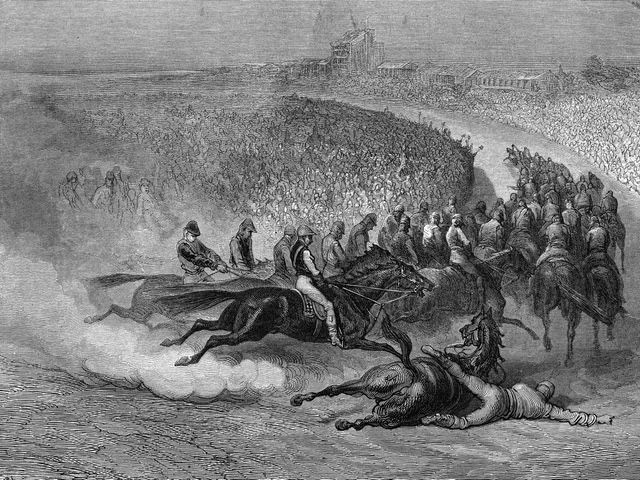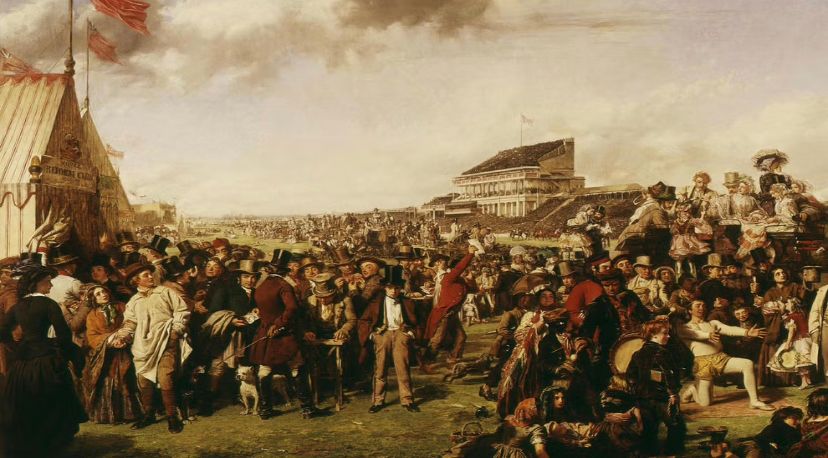This year celebrates the 245th edition of the Epsom Derby, a lasting event in the English sporting calendar since the 17th century. With a long-standing history, the race at Epsom Downs in Surrey has been a beloved tradition for the royal family across generations. Particularly, it attracted notable figures such as King Charles II and diarist Samuel Pepys during its early years. The racecourse gained infamy when suffragette Emily Davison tragically lost her life in 1913 after intentionally stepping in front of King George V's horse.
The Epsom Derby, typically known for its festive atmosphere, elegant hats, and celebrations, has been remarkably captured in William Powell Frith's expansive oil painting named"The Derby Day" (1856-58). Since its initial display at the Royal Academy in London in 1858, the artwork has become a beloved favourite among the British public. It gained such immense popularity that a rail had to be installed to manage the crowds impatient to examine the painting more closely.
Historian Mary Cowling aptly described "The Derby Day" as an instantly recognisable and distinct historical depiction of a significant social occasion. The painting serves as a unique historical record, capturing the meaning and spirit of the event for generations to appreciate and understand.
It is a famous painting that offers a glimpse into Victorian England and its social dynamics during one of the rare national events where people from different classes blended. The artwork captures a cross-section of society, showcasing the interaction between the upper and lower classes in a social setting.

The painting emphasises the unique nature of Derby Day, where social divisions were momentarily set aside, allowing people from different classes to come together and engage in shared experiences. It reflects a rare instance where individuals from contrasting social backgrounds could interact and engage in a social atmosphere that oversteps their usual class boundaries.
It also effectively portrays the sense of anticipation and joy that infiltrates the air, providing viewers with a vivid look into the exuberance and vigour of the crowd engaged in leisurely activities.
In Frith's flawlessly detailed landscape, there are a total of 88 distinct characters portrayed. The scene encloses a wide range of individuals, including elegantly dressed men in top hats riding in carriages accompanied by their mistresses and courtesans. It also features an acrobatic display, a family enjoying a picnic, gamblers entering the Reform Club tent, and spectators watching a "thimble-rigger" while gipsy fortune tellers, cigar sellers, and prostitutes seek the attention of the crowd. In the foreground, a young boy, who appears to have run out of luck, empties his pockets.
Amidst the festive and vibrant atmosphere, Frith's underlying joke is subtly presented: everyone in the painting has turned their backs on the actual race. This clever observation is readily apparent, emphasising the irony of the situation and adding a humorous touch to the artwork. Despite being at a horse racing event, the focus of the characters is diverted elsewhere, highlighting the various and captivating activities occurring simultaneously during the Derby Day celebration.
The painter, who lived from 1819 to 1909, admired the Victorian pseudosciences of phrenology and physiognomy. He believed that a person's inner qualities could be discovered through their physical appearance. This belief is reflected in his work, including his enthusiastic but cautiously pedantic focus on the dishonesty displayed in a Dickensian manner. It is not surprising to discover that Frith himself created a drawing of the distinguished novelist in 1859.
During his initial visit to the race in 1856, Frith accompanied fellow artist Augustus Egg and was inspired to sketch the crowds of visitors. In his 1895 autobiography, he expressed gratitude for the experience, stating that the race held little interest for him in terms of the actual competition, but it provided him with a valuable opportunity to observe and study life and character.
While holidaying in Folkestone, Frith shared his drawing with his friend Jacob Bell, a wealthy chemist. Impressed by the artwork, Bell commissioned Frith to incorporate it into a larger landscape painting measuring 40 inches by 88 inches. The commission came with a substantial fee of £1,500.
Frith had previously demonstrated his expertise in capturing scenes of leisure and crowds. In 1854, he painted "Life at the Seaside, Ramsgate Sands," which was later purchased by Queen Victoria. In 1862, he continued his ambitious and active style with "Railway Station," depicting the chaotic scene of people boarding the Great Western Railway at Paddington. If Frith were alive today, there is no doubt that he would have skillfully portrayed the vibrant sea of roisterers at events like Glastonbury, capturing the essence of the atmosphere and energy.
During 15 months, Frith dedicated himself to working on the painting. To accurately depict the various characters in the scene, he enlisted the help of several models who posed in his studio. Among them were a father and son acrobatic duo from Drury Lane and a jockey named Bundy. Bundy, after enduring discomfort while sitting on a hobby horse, expressed to Frith that he would rather ride the wildest live horse than mount the wooden one again.
Frith sought assistance from his friend John Frederick Herring, a highly skilled painter known for his illustrations of racehorses. Herring's expertise proved priceless in capturing the authenticity of the equine subjects within the painting.
Furthermore, Frith enlisted the aid of photographer Richard Howlett. Howlett was tasked with capturing photographs from the roof of a cab, specifically focusing on distinct groupings of figures during the 1857 race. These photographs served as references for Frith, aiding him in accurately representing the diverse and unique characters occupying the scene.
In 1863, Aaron Green created a painting titled "Epsom Downs," which brought a striking resemblance to Frith's "Derby Day."

In 1872, the renowned French engraver and illustrator Gustave Dore attended the grand event. Taking a unique approach, Dore sketched the events taking place on the racing track itself. One of his notable depictions captured a jockey being thrown off his horse, creating a moment of intense drama.
To sum up, the painter's interest in phrenology and physiognomy influenced his artistic approach, particularly in emphasising the moral aspects of human behaviour. His visit to the race in 1856 allowed him to capture the soul of the event and delve into the complexities of human life through his sketches.

